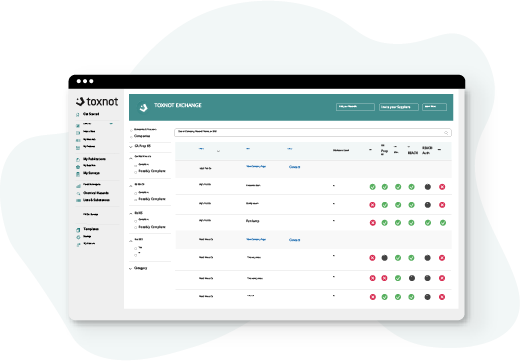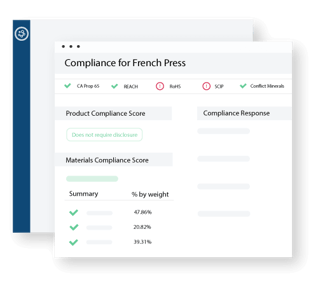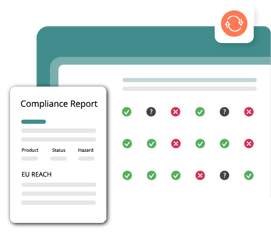5 min read
REACH SVHC List: How to Handle Substances of Very High Concern
The ECHA's "substances of very high concern," or SVHCs, represent a threat to human health and safety, as well as the...
Toxnot is now 3E Exchange
Learn MoreCompliance is an important part of the manufacturing and sales process, but keeping up to date with regulations, including California's Proposition 65, can be tricky.
Looking for a software solution? Stay up-to-date and easily screen for potentially harmful substances with 3E Exchange's comprehensive product compliance software. Our tools empower your team to manage supply chain and materials data in one place. Once the data is compiled, your team can check chemicals and products against a wide range of legislation and standards.

Manufacturers and companies use 3E Exchange as a Prop 65 compliance solution to:
3E Exchange simplifies reporting, data collection, tracking, audits, data analysis, and compliance determinations. Our user-friendly software combines the product data your business already has with industry standards and regulations.
Environmental and chemical regulations are complex and constantly evolving. But when the information is easier to review and understand, all of this data can start to work for your company. It also helps your company work to better public interest, better inform Californians and others of potential risks, and avoid significant exposures that can impact human health.

Our single platform brings vast amounts of supply chain, compliance, and materials data to your fingertips. Add the materials used in your products (alongside other supplemental data including test results, certifications, and SDS files) to see everything in one centralized space.
3E Exchange checks for compliance across a wide range of industry standards, including California Proposition 65, and delivers in-depth reporting on anything that negatively affects the product score. Explore how material and supplier swaps affect your product's level of compliance.
3E Exchange also stays current with product and regulatory changes, updating scores accordingly and notifying you about any issues or hazardous substances. As California updates its list of potentially toxic chemicals, 3E Exchange updates and adjusts our own system.
By law, the Office of Environmental Health Hazard Assessment updates the Prop 65 chemicals list at least once a year. Planning for updates is an important part of continued compliance. When things change, you'll see updates reflected in your reports and receive notifications on the status of your products.
Integrated supplier data, the ability to send surveys to suppliers, data inheritance, and a product library are just a few of the features 3E Exchange offers. These features all work together, in one integrated place, to help you gather all the materials data for your products in one simple place.
When you use 3E Exchange, everything you need to determine Prop 65 compliance is already there. The data is easy to use, analyze, and share.
![]()
If you're already using 3E Exchange for your other ESG goals, it's a simple matter of running your products through the Proposition 65 filter to see how they perform. That's because 3E Exchange compiles all your chemicals, materials, and ingredient information in one place so you can quickly analyze for risks, impact on the environment, potentially hazardous substances, and more.
Not using 3E Exchange? Our all-in-one software solution scales to handle whatever level of usage you need. Get started by adding one finished product, then see everything you can do with your data.
Any manufacturer or company that wants the opportunity to sell products in the California needs to be able to navigate the state's chemicals regulations. In practice, this means that most companies selling products anywhere within the United States must comply with Prop 65.

You've likely seen stickers or labels on products that warn about the chemicals or materials they contain. Many of these were added to satisfy California's strict regulations and labeling requirements around potentially harmful substances.
The full name of this California proposition is the Safe Drinking Water and Toxic Enforcement Act of 1986. Proposition 65 is overseen by Office of Environmental Health Hazard Assessment (OEHHA). That office, in turn, is part of the California Environmental Protection Agency (CalEPA).
This regulation was established in 1987 and was created to help keep California residents informed and aware of potential exposures to chemicals that might cause "cancer, birth defects, or reproductive harm." It also seeks to prevent such chemicals from ending up in drinking water.


Proposition 65 is one of the furthest-reaching sets of chemical exposure regulations in the United States. The burden to achieve compliance falls on companies and businesses operating within or selling products in California.
Even if your company isn't within California, or even the United States, you will still need to adhere to Prop 65 standards if you plan to do business there. That can include selling products within the state, as well as doing any kind of manufacturing there.
Companies that do not currently do business in California may still wish to ascertain their compliance. Having chemical and materials information on hand (and being able to show a transparent supply chain) is a big selling point for retailers and businesses who may want to purchase your product there.
In general, knowing your compliance levels and even proactively labeling products can help future-proof your business. Products that are properly tracked and labeled can be sold in California without fear of incurring fines. Therefore, by following these regulations before it's necessary, businesses can future-proof their product sales plan and leave the opportunity for expansion open.

Any business operating within California that exposes people to one of the chemicals listed will need to be aware of and comply with regulations. The OEHHA offers guidance for companies seeking to remain on the right side of the law.
The OEHHA also has information on exemptions. These may apply to certain small businesses with fewer than 10 employees and government agencies. There are also allowances, or "safe harbor" levels, for certain substances; California's regulators consider small quantities of these chemicals to be below the threshold for harm to human or environmental health. They consider these levels to be too small to cause birth defe
These rules go far beyond manufacturers. Examples of Prop 65 requirements could include:
Different business types and products will need to take different actions depending on their industry. Warning labels, newspaper announcements, and more are all within the purview of the regulations.

Companies and manufacturers who sell or manufacture products or chemicals must navigate a global set of laws and regulations. These can include REACH, RoHS, conflict mineral concerns, and SCIP legislation, as well as the Prop 65 regulations discussed here.
While there is some overlap between certain standards, compliance with one set of standards does not automatically mean compliance with another. In addition, reporting and labeling procedures can vary vastly between different sets of legislation, as well as where the product is produced and sold.
So, how should responsible companies keep everything straight? A centralized material substance data, regulation, and product tracking solution can help businesses remain up to date with requirements.
That's why Toxnot integrates all of these regulations and more. It serves as a centralized spot for teams to screen their products and materials against all of the standards they must comply with, as well as to explore entering additional markets where different standards might apply.
As part of Proposition 65, California keeps an updated list that tracks chemicals it considers "known to cause cancer, birth defects or other reproductive harm."
By law, the list is required to be updated at least once a year.
What does this mean for businesses and manufacturers? Just because a product was Proposition 65 compliant last year doesn't mean it will pass muster this year, or the year after that.
3E Exchange updates regularly as regulations change. By tracking materials and suppliers in one centralized location, users can spot potential problems early and adjust in a timely manner.

California's Safe Drinking Water and Toxic Enforcement Act of 1986 regulations can be difficult to navigate. The price of breaking these regulations and running afoul of maximum allowable dose levels can be steep: fines for non-compliance and labeling violations can run up to thousands of dollars a day.
3E Exchange simplifies the entire process. It is an all-in-one compliance and EGS solution that brings all of your materials, supply chain, and manufacturer data together in one place, all alongside regulatory standards. It also simplifies data acquisition, with questionnaires and more to make importing all of the data simpler.
See how your products score according to various standards, including Prop 65, as well as how certain materials adjustments affect your products' scores. The dashboards and filtering allow your team to take control of your data and use it for better business intelligence.
Join thousands of companies who trust 3E Exchange. Instantly create an account and begin leveraging data to generate tangible value in minutes. With your forever free account you maintain complete control of your own data securely on 3E Exchange.
Your products. Your data. Start now.
The ECHA's "substances of very high concern," or SVHCs, represent a threat to human health and safety, as well as the...
We are pleased to announce that Toxnot is now 3E Exchange. The word, “exchange” conjures up images of a two-way street,...
Are you a manufacturer embarking on your sustainability or product compliance journey and not sure where to start? No...